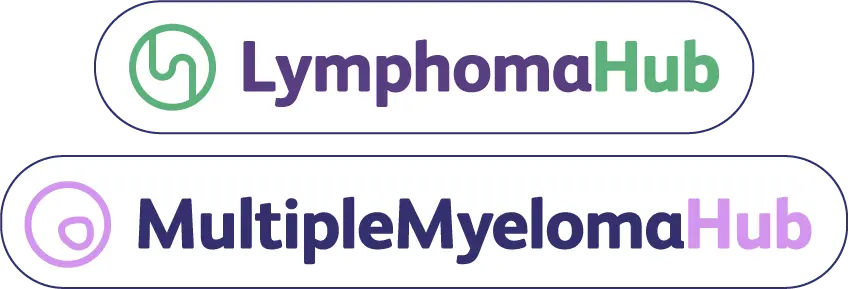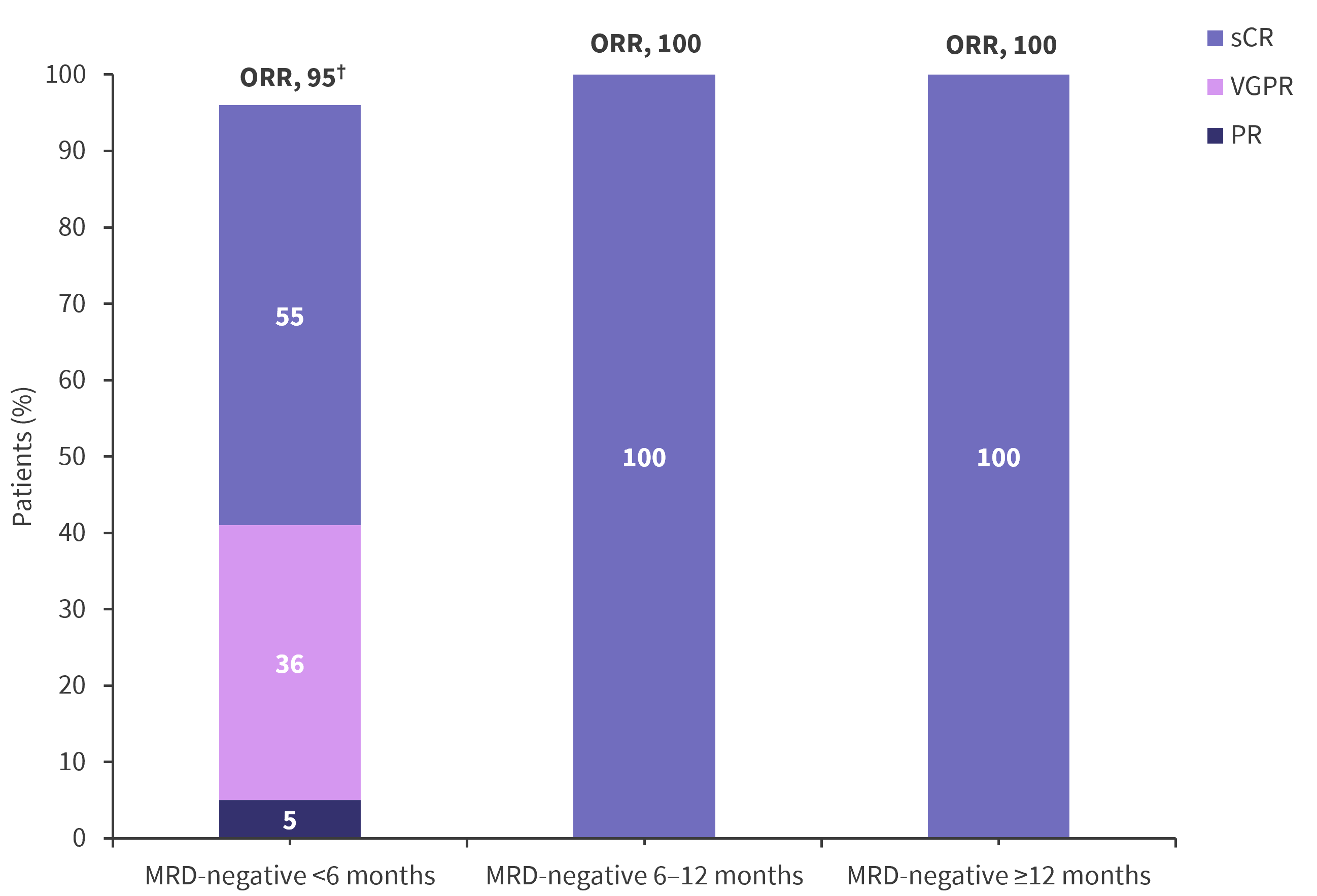All content on this site is intended for healthcare professionals only. By acknowledging this message and accessing the information on this website you are confirming that you are a Healthcare Professional. If you are a patient or carer, please visit the International Myeloma Foundation or HealthTree for Multiple Myeloma.
The Multiple Myeloma Hub uses cookies on this website. They help us give you the best online experience. By continuing to use our website without changing your cookie settings, you agree to our use of cookies in accordance with our updated Cookie Policy
An expert panel hosted by

Sequencing immune-based therapies in B-cell malignancies
with Ulric Jäger, Sagar Lonial, and Krina Patel

Saturday, June 15 | 18:00-19:30 CEST
Register nowThis independent education activity is sponsored by Bristol Myers Squibb. All content is developed independently by the faculty. Funders are allowed no direct influence on the content of this activity.
The Multiple Myeloma Hub website uses a third-party service provided by Google that dynamically translates web content. Translations are machine generated, so may not be an exact or complete translation, and the Multiple Myeloma Hub cannot guarantee the accuracy of translated content. The Multiple Myeloma Hub and its employees will not be liable for any direct, indirect, or consequential damages (even if foreseeable) resulting from use of the Google Translate feature. For further support with Google Translate, visit Google Translate Help.
Outcomes in patients with MM achieving MRD negativity after treatment with cilta-cel: CARTITUDE-1
Bookmark this article
Ciltacabtagene autoleucel (cilta-cel), a B-cell maturation antigen-directed autologous chimeric antigen receptor T-cell therapy, is approved by the U.S. Food and Drug Administration for treatment of patients with relapsed/refractory multiple myeloma (R/R MM) after ≥4 lines of therapy.1 The Multiple Myeloma Hub has previously reported various updates on CARTITUDE-1 trial (NCT03548207). Previous findings from CARTITUDE-1 have demonstrated deep and durable responses with cilta-cel, with 56 of 61 evaluable patients in phase Ib/2 achieving minimal residual disease (MRD) negativity.1
During the 11th Annual Meeting of the Society of Hematologic Oncology (SOHO) 2023, Yi Lin presented the latest updates from CARTITUDE 1 trial, focusing on efficacy outcomes and characteristics of patients with R/R MM and sustained MRD negativity following treatment with cilta-cel. We are pleased to summarize the key updates here.
Study design1
The study design and interim data have been reported previously on the Multiple Myeloma Hub. For this analysis, patients achieving sustained MRD negativity were defined as those with:
- Two MRD-negative results following cilta-cel infusion, and
- No MRD-positive results prior to progression or subsequent therapy, which were ≥6 months apart.
MRD negativity was assessed at baseline, on Day 28, and 6, 12, 18, and 24 months after cilta-cel infusion as a key secondary endpoint of the phase II part of the CARTITUDE-1. An additional sample was assessed at the time of suspected complete response and every 12 months until progressive disease.
Results
Disease and patient characteristics in MRD subgroups
A total of 56 patients achieving MRD negativity were included in the analysis. Baseline characteristics were comparable between patients with sustained ≥6 months versus <6 months MRD negativity (Table 1). However, patients with sustained MRD negativity for ≥12 months showed a tendency towards longer time since diagnosis.
Table 1. Disease and patient baseline characteristics*
|
|
|
Sustained MRD negative |
|
|---|---|---|---|
|
Characteristics, % (unless stated otherwise) |
MRD negative <6 months |
6–12 months |
≥12 months |
|
Median age (range), years |
59.5 (51–75) |
66 (54–77) |
63 (43–78) |
|
Sex, female |
36.4 |
60 |
54.2 |
|
Median time since diagnosis (range), years |
4.8 (1.6–16.3) |
5 (1.6–8.1) |
7 (2.5–18.2) |
|
Plasmacytomas |
27.3 |
20 |
8.3 |
|
Extramedullary |
18.2 |
20 |
4.2 |
|
Bone-based |
9.1 |
0 |
4.2 |
|
High-risk cytogenetic profile |
27.3 |
20 |
25 |
|
ECOG PS |
|
|
|
|
0 |
45.5 |
40 |
50 |
|
1 |
45.5 |
60 |
50 |
|
2 |
9.1 |
0 |
0 |
|
ISS stage |
|
|
|
|
I |
68.2 |
50 |
75 |
|
II |
27.3 |
20 |
16.7 |
|
III |
4.5 |
30 |
8.3 |
|
≥50% tumor BCMA expression |
100 |
66.7 |
88.9 |
|
Previous auto-HSCT |
86.4 |
60 |
91.7 |
|
Previous allo-HSCT |
4.5 |
0 |
8.3 |
|
Median number of previous LOT |
5 (3–18) |
4.5 (3–12) |
5.5 (3–11) |
|
Triple class refractory† |
95.5 |
80 |
87.5 |
|
Penta-drug exposed‡ |
81.8 |
70 |
79.2 |
|
Penta-drug refractory‡ |
27.3 |
40 |
29.2 |
|
Refractory to last LOT |
100 |
100 |
100 |
|
allo, allogeneic; auto, autologous; BCMA, B-cell maturation antigen; CD, cluster of differentiation; ECOG PS, Eastern Cooperative Oncology Group performance status; HSCT, hematopoietic stem cell transplantation; ISS, International Staging System; IMiD, immunomodulatory drug; LOT, line of therapy; MRD, minimal residual disease; PI, protease inhibitor. |
|||
Response rates
Stringent complete response was achieved by all patients with sustained MRD negativity ≥6 months. Comparison of response rates in patients with >6 months versus ≥6 months MRD negativity are shown in Figure 1.
- Median duration of response was longer in patients with sustained versus <6 months MRD negativity (not evaluable vs 10.3 months).
- Similarly, progression-free survival was increased in patients with sustained versus <6 months MRD negativity (not evaluable vs 11 months).
Figure 1. Response rates in MRD subgroups*

MRD, minimal residual disease; ORR, overall response rate; PR, partial response; sCR, stringent complete response; VGPR, very good partial response.
*Data from Lin.1
†ORR = sCR + VGPR + PR.
Conclusion
This analysis from CARTITUDE-1 demonstrated that achievement of sustained MRD negativity was not predicted by baseline patient and disease characteristics. However, patients achieving sustained MRD negativity for ≥12 months showed a tendency towards longer time since diagnosis. Deeper responses were achieved in patients who achieved MRD negativity for ≥6 months versus <6 months. In addition, patients with MRD negativity for ≥6 months showed longer duration of response and progression-free survival compared with those achieving <6 months MRD negativity.
- Lin Y. Efficacy outcomes and characteristics of patients with multiple myeloma (MM) who achieved sustained minimal residual disease negativity after treatment with ciltacabtagene autoleucel (cilta-cel) in CARTITUDE-1. Oral poster #206. 11th SOHO Annual Meeting; Sep 6−9, 2023; Houston, TX, US, and Virtual.
Related articles
Newsletter
Subscribe to get the best content related to multiple myeloma delivered to your inbox






